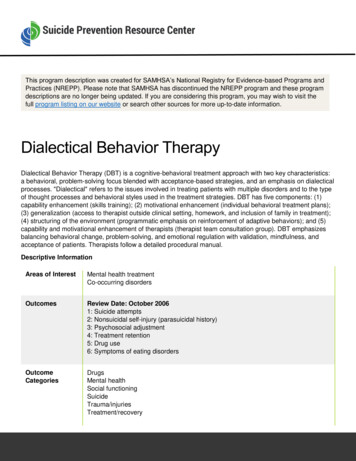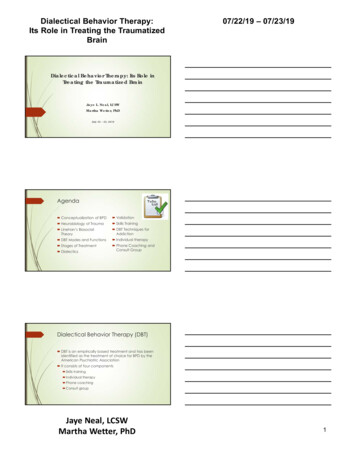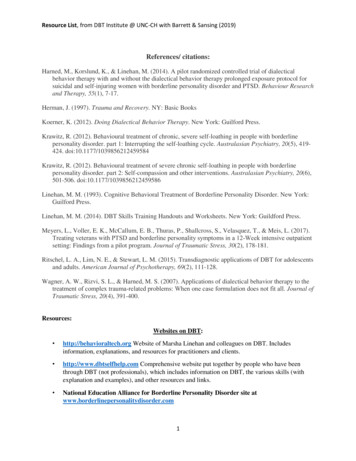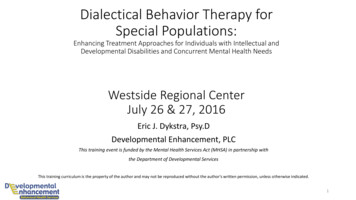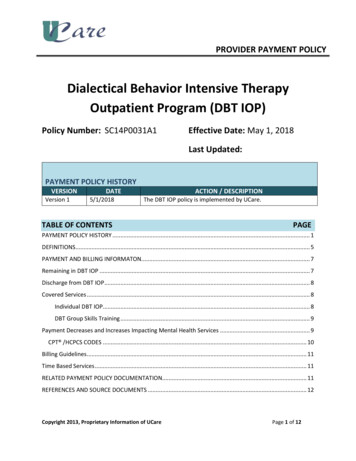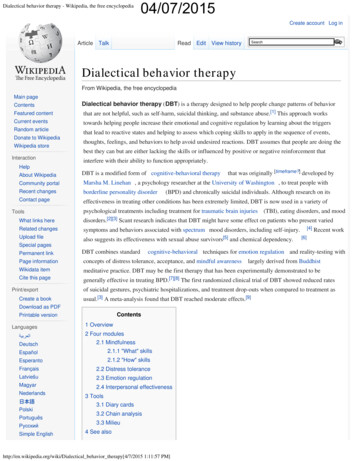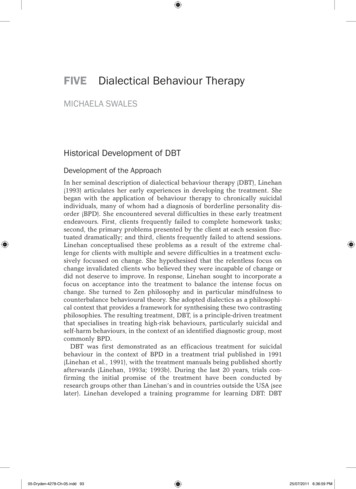
Transcription
five Dialectical Behaviour TherapyMichaela SwalesHistorical Development of DBTDevelopment of the ApproachIn her seminal description of dialectical behaviour therapy (DBT), Linehan(1993) articulates her early experiences in developing the treatment. Shebegan with the application of behaviour therapy to chronically suicidalindividuals, many of whom had a diagnosis of borderline personality disorder (BPD). She encountered several difficulties in these early treatmentendeavours. First, clients frequently failed to complete homework tasks;second, the primary problems presented by the client at each session fluctuated dramatically; and third, clients frequently failed to attend sessions.Linehan conceptualised these problems as a result of the extreme challenge for clients with multiple and severe difficulties in a treatment exclusively focussed on change. She hypothesised that the relentless focus onchange invalidated clients who believed they were incapable of change ordid not deserve to improve. In response, Linehan sought to incorporate afocus on acceptance into the treatment to balance the intense focus onchange. She turned to Zen philosophy and in particular mindfulness tocounterbalance behavioural theory. She adopted dialectics as a philosophical context that provides a framework for synthesising these two contrastingphilosophies. The resulting treatment, DBT, is a principle-driven treatmentthat specialises in treating high-risk behaviours, particularly suicidal andself-harm behaviours, in the context of an identified diagnostic group, mostcommonly BPD.DBT was first demonstrated as an efficacious treatment for suicidalbehaviour in the context of BPD in a treatment trial published in 1991(Linehan et al., 1991), with the treatment manuals being published shortlyafterwards (Linehan, 1993a; 1993b). During the last 20 years, trials confirming the initial promise of the treatment have been conducted byresearch groups other than Linehan’s and in countries outside the USA (seelater). Linehan developed a training programme for learning DBT: DBT05-Dryden-4278-Ch-05.indd 9325/07/2011 6:36:59 PM
94Cognitive Behaviour TherapiesIntensive Training. This is a 10-day programme consisting of two 5-weekblocks of teaching separated by 6–8 months of development work. Thefirst DBT Intensive Training course was conducted in Seattle in 1993. Thistraining programme has seeded over 500 DBT programmes in the USA(Hibbset al., 2010). DBT is also offered as a treatment in a number ofEuropean countries (Spain, Germany, Netherlands, UK) and in other partsof the English-speaking world (Australia and New Zealand).DBT in the UKThe first DBT team from the UK trained in Seattle in 1994/95. In the ensuing years a small number of teams continued to train in the USA. In 1997,the first UK Intensive Training programme ran in the UK with the supportof the Linehan Training Group, a group of specialist trainers in DBTtrained by the treatment developer. Since 1997, the British Isles DBTTraining Team, a team of UK practitioners trained both to adherence in thetreatment and as trainers in the treatment, has trained most British teams.Recent research calculated that the British training programme has seeded240 programmes (Swales et al., 2010). Treatment programmes report,despite positive experiences of treatment delivery, significant problems inimplementation of the treatment which relate primarily to lack of organisational support for specialised treatment programmes that require significant investment of practitioner time (Taylor et al., Forthcoming).Theoretical UnderpinningsMajor Theoretical ConceptsDBT rests on three core theoretical pillars: behaviourism, Zen and dialectics. At its core, DBT is a behavioural treatment. Behaviourism influencesthe principles and practices of the treatment in several ways. DBTembraces a radical behaviourist philosophy in that anything an organismdoes – thinking, sensing, emoting, acting – constitutes behaviour.Conceptualising in this way, for example, transforms the understanding ofdiagnosis. From a behaviourist perspective, the diagnostic criteria are simply lists of overt and covert behaviours, more or less behaviourally defined.Thus, therapists can intervene with any behaviour engaged in by the clientusing principles of behaviour change. Following behaviour change, whenthe client no longer engages in the overt behaviours and no longer experiences the covert behaviours, the diagnosis has gone. This perspective oftenprovides clients with a more hopeful perspective than hitherto. In additionto providing a theoretical conceptualisation of the difficulties of the client,the behavioural focus drives the central treatment strategies of DBT: problem solving. Regardless of the problem, DBT therapists spend the first part05-Dryden-4278-Ch-05.indd 9425/07/2011 6:36:59 PM
Dialectical Behaviour Therapy 95of each session conducting behavioural analyses of clients’ behaviourstargeted for change. These analyses form the basis for comprehensive solution analyses of clients’ difficulties (see below).For clients with serious and multiple problems, as discussed earlier, arelentless focus on change can be difficult to tolerate. Zen philosophy,emphasising acceptance of reality as it is, provides a counterpoint to thispush for change. In embracing Zen, DBT therapists accept the client as heor she is in the moment, the client’s current state of progress and the statusof the therapeutic relationship. In so doing, therapists model for clients howto accept themselves and reality at it is in the moment. To promote an attitude of acceptance, DBT therapists practice mindfulness themselves andteach mindfulness to clients. In contrast to other psychological treatmentsutilising mindfulness that focus on clients engaging in extensive practices,DBT teaches mindfulness as a series of seven skills (Linehan, 1993b), eachof which is rehearsed in shorter practices. These basics of mindfulness aretaught in DBT skills groups. DBT therapists strengthen and generalise theseskills by noticing when clients become unmindful and coaching in how toremain more focussed in the present moment without judgement. In assisting clients to solve current problems DBT therapists balance solutionsbased on both acceptance-based skills and change-based skills.Dialectical philosophy builds a bridge between acceptance and changewithin the treatment. As a world view, dialectics emphasises interconnectedness and wholeness, guarding against a unipolar perspective on reality.DBT therapists recognise and welcome multiple perspectives on problems.In endeavouring to synthesise data from more than one perspective, moreeffective solutions may be found.How Client Problems are ConceptualisedPrimacy of AffectLinehan proposes that the primary difficulty for clients with a diagnosisof BPD is the experience and regulation of affect. The central difficulty ofmanaging affect leads to the emotional lability that is at the heart of BPD.Emotional ‘dysregulation’, as Linehan refers to it, drives difficulties inother systems. Thus, clients experience interpersonal dysregulation (chaotic relationships and fears of abandonment), self-dysregulation (identitydisturbances and sense of inner emptiness), cognitive dysregulation (paranoid ideation and dissociative thinking) and behavioural dysregulation(suicidal and impulsive behaviours). Conceptualising the diagnosis according to these systems of dysregulation articulates a central component ofDBT conceptualisation that criterion behaviours of the BPD diagnosis areeither a natural consequence of being emotionally dysregulated (chaoticrelationships, identity and cognitive disturbances) or represent attempts tore-regulate (suicidal and impulsive behaviours). DBT therapists, therefore,in conceptualising client problems, place a strong emphasis on affect and05-Dryden-4278-Ch-05.indd 9525/07/2011 6:36:59 PM
96Cognitive Behaviour Therapiesunderstanding the relationship between the clients presenting problemsand affect.Capability and Motivational DeficitsDBT is based on a biosocial theory that explains the origins of the emotionalvulnerability of BPD clients as a consequence of biological vulnerabilitytransacting with invalidating environments. Linehan suggests that clientswho develop BPD are biologically vulnerable to emotion regulation difficulties either as a result of genetic, intrauterine or neurobiological factors. Suchbiological predispositions will only lead to BPD in certain environmentalcontexts. Linehan described invalidating environments as the crucial typeof environment that in concert with biological vulnerabilities transacts overtime, leading to the development of BPD. Invalidating environments havethree major characteristics. First, these environments fail to recognise andvalidate the individual’s own private experiences, frequently dismissingthem as inaccurate, ill-judged or indicative of major character flaws.Second, in the face of emotional escalation, invalidating environments intermittently reinforce extreme emotional displays. Third, invalidating environments oversimplify the solution of social and emotional problems. Thesefeatures of invalidating environments lead to several difficulties for clientswith BPD. Frequently, clients are unable to recognise and label their emotional experiences in a manner normative to the wider community. As theyhave not received accurate feedback about their own emotional responsesto situations and the validity of their responses, they learn to distrust or toignore their own emotional responses. For significant periods of time,invalidating environments fail to attend to emotional communications ordistress but then intermittently reinforce escalations. Thus, clients learnt tooscillate between the inhibition of emotional responses and extreme behaviours, for example suicidal behaviours. As invalidating environments tendto imply that the solution to life’s challenges lies in ‘pulling yourself up byyour own bootstraps’, clients have not learnt how to solve complex problems by breaking them down into component parts and also tolerating thefrustration of not having solved the problem yet. Whilst a degree of invalidation is common in all environments, development of BPD is more likelywhen invalidation is chronic or severe, or when the individual is highlybiologically vulnerable. The transactional theory of the development ofBPD, however, allows for the development of BPD in circumstances wherethere may be relatively minor biological vulnerability in the context of lowlevels of invalidation. In these circumstances, the poorness-of-fit betweenan individual and their environment may result in low levels of invalidationincreasing the vulnerability in the child, resulting in subsequent, moreintense levels of validation that further disrupt the child’s capacity to emotionally regulate and, over years, lead to greater disturbance.Consequent upon the invalidating environment that has failed to teachclients how to manage emotions, clients with BPD have significant05-Dryden-4278-Ch-05.indd 9625/07/2011 6:36:59 PM
Dialectical Behaviour Therapy 97Table 5.1Functions and modes of a DBT programmeFunction of the DBT programmeExample modalitiesEnhance client capabilitiesSkills groupsEnhance client motivationDBT individual psychotherapyEnsure generalisationTelephone consultationStructure the environment:a) Treatmentb) Clienta) Management of the DBTprogrammeb) DBT family therapyEnhance therapist capabilities and motivationConsultation teamcapability deficits in the management of emotions, relationships andbehaviour and, in addition, clients have significant motivational deficitsthat impede effective resolution of their difficulties. Thus, DBT rests on acapability and motivational deficit model of BPD and recommends a comprehensive treatment programme to address these problems. DBT treatment programmes possess five functions, each with correspondingmodalities (see Table 5.1).Enhancing client capabilities in the realm of affect regulation, interpersonal skills and crisis management represents a core component of a DBTprogramme. Most programmes address this function by running DBT skillsgroups, which follow a core curriculum (mindfulness, interpersonal effectiveness, emotion regulation and distress tolerance) described in detail inthe Skills Training Manual (Linehan, 1993b). DBT individual psychotherapyfocuses on identifying and resolving motivational impediments to behaviour change such as problematic affects, cognitions or reinforcement contingencies. To ensure generalisation of treatment gains outside of thetreatment environment, DBT programmes contain specific modalitiesdesigned to both generalise skills and also reduce suicidal crises. Mostcommonly, DBT programmes provide telephone consultation between theDBT individual therapist and the client between sessions to fulfil this function. In recognition of the challenge of treating clients with BPD effectivelyand of the complexity of the problems presented by the clients, DBT programmes also attend to enhancing the capabilities and motivation of thetherapists. DBT therapists meet weekly in consultation team, during whichthey receive consultation and supervision on their treatment of clients.Finally, DBT programmes require modalities to assist in maintaining thestructure of the treatment programme and, in some cases, to promote treatment gains within the clients’ natural environments.Behavioural ConceptualisationFollowing on from the behavioural approach to diagnosis, DBT conceptualises all of the problems of the client in behavioural terms. Thus, DBTtherapists, in pre-treatment, discuss with clients the primary behavioural05-Dryden-4278-Ch-05.indd 9725/07/2011 6:36:59 PM
Cognitive Behaviour Therapies98Table 5.2 Hierarchy of behaviours in Stage 1 of DBTPrimary targetsLife-threatening behaviours, including:·····Suicidal behavioursNon-suicidal self-injuryHomicidal behavioursSerious aggressive actsImminently life-threatening behaviours.Threats and urges to engage in the above.Significant changes in suicidal/homicidal ideation.Therapy-interfering behaviours of the client and therapistQuality-of-life interfering behaviours, including:··Behaviours associated with other psychiatric diagnosesSeriously destabilising behaviours, e.g. frequent hospitalisations, violent behaviour,forensic behaviours.Increase behavioural skillstargets for change. The specific behaviours of the client are then arrangedhierarchically (see Table 5.2) according to the scheme utilised within DBT.During treatment itself, each week therapists select a specific example ofone of the target behaviours that form the basis for the chain and solutionanalysis within the session.DBT as a behavioural treatment is based on behavioural theory. Thus,DBT therapists apply learning theory to the problems of the client. In analysing client problems, DBT therapists seek to identify classical conditioning links in the sequence of events leading up to and operant conditioninglinks following target behaviours. For example, a client with a history ofsexual abuse frequently dissociated at night on entering her bedroomwhen she saw her bed. As a child her father, just before bed, had frequently sexually abused her. For her, the bed was a cue that elicited anxiety and dissociation. This represented a classically conditioned link.Subsequent to dissociation, the client would cut herself to terminate thedissociative state which she experienced as aversive. Thus, cutting wasnegatively reinforced by the removal of the dissociative state. DBT therapists would then apply the appropriate intervention to treat each link. Inthis case, the therapist conducted an informal exposure programme to thecue of ‘beds’, helping the client to decrease dissociative behaviours whenpresented with the cue. Emotion regulation skills to manage anxiety as sheapproached bedtime and mindfulness enabled the client to tolerate andbenefit from the exposure programme. To address the operant links, thetherapist taught the client how to become ‘reassociated’ without cutting.Grounding skills were especially useful here, as were some cognitiverestructuring of the client’s beliefs that she deserved to suffer the distressof dissociation because she believed herself culpable in the abuse.05-Dryden-4278-Ch-05.indd 9825/07/2011 6:36:59 PM
Dialectical Behaviour Therapy 99As indicated earlier, DBT applies the treatment to covert as well as overtbehaviours. Thus, principles of learning theory can be applied to thoughtsas well as actions. For example, many clients with a history of repeatedsuicidal behaviours when faced with an emotional difficulty find thinkingabout death soothing. Conceptually, then, the relief from distress negatively reinforces suicidal thinking. DBT therapists intervene both by providing alternative ways to experience relief other than thinking aboutsuicide and also initiate a new learning history by challenging the client’sbelief that suicidal thinking is a solution to life’s difficulties, that is, providing an aversive consequence to suicidal thinking.Practical ApplicationsTherapeutic RelationshipDBT makes several assumptions about the therapeutic relationship: that themost caring thing a therapist can do is to help clients change in ways thatbring them closer to their own goals; that principles of behaviour are universal affecting therapists as much as clients; and that therapists treating clientswith BPD need support. At the start of the pre-treatment phase in DBT,therapists focus on identifying client goals and then explicitly link these tothe goals of treatment. For example, a client who wants to develop betterinterpersonal relationships is helped to see that stopping suicidal behaviourswill increase the likelihood of more mutually supportive relationships; or aclient who wants to feel better is oriented to how the treatment teaches andhelps to implement a range of longer-term solutions to emotional difficultiesthat whilst they lack the immediate affect regulatory capacity of cutting,they also lack the harmful effects on her body, her self-esteem and her family relationships. Occasionally, making these links explicit is more challenging; for example, the client who states that his or her goal in life is to bedead. In these circumstances, the DBT therapist explores what ‘being dead’would do for the client. Frequently, clients will identify that being dead willrelieve emotional suffering or escape intolerable life circumstances. TheDBT therapist in these circumstances must build a case for the treatment toprovide an alternative route to these same ends.As principles of behaviour change are universal, the therapeutic processimpacts therapists as well as clients. DBT recognises this process of reciprocalinfluence in the identification of therapy-interfering behaviours in the targethierarchy by explicitly stating that therapy-interfering behaviour is a ‘twoway street’ and that therapists may engage in behaviours that hinder clientprogress in therapy. DBT therapists need to practise openness in response tofeedback from clients about their own behaviours and develop the capacityto scrutinise the impact of their behaviours with a willingness to modify theirresponses if necessary. Therapists also must remain awake to the impact ofclient’s responses on them. Just as therapists endeavour to shape client05-Dryden-4278-Ch-05.indd 9925/07/2011 6:36:59 PM
100Cognitive Behaviour Therapiesbehaviour, clients’ behaviours may shape therapists behaviour out-ofawareness and sometimes in ways that ultimately are ineffective. For example, a client who was ashamed of her suicidal behaviour became eitheraggressive with the therapist or mute when it was discussed. Both behavioursthe therapists found a challenge to respond to. He tried a number of differentinterventions without success and gradually decreased his focus on the client’s suicidal behaviour. The client did become more comfortable in session,but her suicidal behaviour and high risk continued unchanged. The task ofthe DBT consultation team is to assist therapists in both identifying andchanging these problematic patterns when they arise.In DBT the therapeutic relationship is the major source of contingentrelationships for client progress. Early in the process of behaviour changeclients rarely receive any direct and immediate reinforcement for theirearly change efforts. New emotion regulation skills rarely work with theeffectiveness of suicidal and self-harming behaviours, and small changes ininterpersonal style often go unremarked by the chaotic environments inwhich clients live. The therapist, therefore, is often the only source ofreinforcement to motivate the client to remain in what is often a painfulprocess of change. DBT therapists attend to the impact of their behaviouron clients and use their own behaviour strategically to promote change.Just as the therapist will notice and reinforce any small effort that the client makes towards using non-harming methods to manage emotions, he orshe will also refrain from reinforcing problematic behaviours. So, forexample, DBT therapists will take care to eliminate any increase in warmthand validation in response to suicidal communications, tending to remainmatter-of-fact and reserving increases in warmth and validation for clients’non-suicidal problem-solving efforts.A significant component of the role of the DBT therapist is to be both ateacher and a consultant to the client. In skills training groups, therapistsexplicitly teach skills and indeed the format of the class is more that of aneducational class than a therapy group. In individual therapy, therapistsmay help clients acquire new skills, but primarily they focus on assistingclients to strengthen new skills. DBT is entirely open with clients aboutits philosophy and its proposed methods of action. DBT therapists therefore orient clients to therapeutic strategies, especially to the four changeprocedures (skills training, cognitive modification, exposure and contingency management), to promote clients’ capacity to mange their ownbehaviour.Whilst DBT therapists actively teach, model and demonstrate to clients and take an active problem-solving stance throughouttherapy, their primary stance for solution implementation is consultationto the patient. Thus, rather than the therapist intervening to solve problems on behalf of the client with other professionals or other parts of thetreatment system, the DBT therapist coaches the client on how toapproach and solve whatever problems he or she is experiencing withothers.05-Dryden-4278-Ch-05.indd 10025/07/2011 6:36:59 PM
Dialectical Behaviour Therapy 101Strategies of TreatmentWithin DBT all treatment techniques and strategies are arranged on thedialectic of acceptance and change. The core treatment strategies are problem solving, representing the change pole, and validation, representing theacceptance pole.Problem SolvingCentral to DBT is problem solving; standard CBT problem solving with a fewnovel twists. Each therapy session, the DBT therapist selects the most highpriority target behaviour that the client has engaged in the preceding weekfor analysis. First, the therapist obtains a precise definition of the topographyand severity of the target behaviour before conducting a behavioural analysisof all the links in the sequence of events that led up to and followed thebehaviour. In conducting the chain analysis the therapist seeks to identifyand distinguish affective, cognitive and overt behavioural links and to clarifywhich of the links in the sequence of events are dysfunctional, and which ofthem are controlling variables with respect to the target behaviour.The therapist uses the behavioural analysis as a basis for the solutionanalysis. If the therapist assesses that the problematic link occurred as aresult of a skills deficit, then, if the client does not yet know the skill, thetherapist teaches a new skill, or, if the client has acquired the basics of theskill in the skills training group, then the therapist strengthens the skill andassists the client to generalise the skill to the new context. If the problematic link is an unwarranted affect, or where the affect is warranted but theintensity of affect is unwarranted, the therapist may use exposure as asolution. When problematic cognitions interfere with skilful behaviour,then the therapist will use cognitive modification procedures. When moreskilful behaviour is within the client’s repertoire of behaviours but is lowdown in the response hierarchy, or where more dysfunctional behavioursare higher in the response hierarchy, then the therapist utilises contingency management procedures to modify client responses.Once the therapist has selected a solution or range of solutions to addressthe target behaviour, the therapist rehearses the new behaviours with theclient in session. Rehearsal provides the therapist with an opportunity toidentify any problems in understanding or implementing the new behaviour and also to shape successive approximations to more skilful behaviour.Finally, the therapist considers with the client the detailed practicalities ofimplementing the new solutions outside the therapy session and troubleshoots any potential problems in generalising the new behaviours.ValidationBalancing the problem-solving focus, DBT therapist distils from themyriad responses of the client – emotions, cognitions and behaviours –those which are valid, and feeds this back to the client. The therapist05-Dryden-4278-Ch-05.indd 10125/07/2011 6:36:59 PM
102Cognitive Behaviour Therapiesthus provides a counterpoint to the invalidating environment by modelling and then teaching clients how to validate their own responses.Dialectically, therapists simultaneously validate the valid aspects of theclient’s responses whilst invalidating their invalid aspects. For example,a client may repeatedly cut herself in order to relieve anxiety. Cutting is,therefore, valid both because it relieves anxiety and because most peopleseek methods to reduce unpleasant levels of anxiety. The behaviour isinvalid, however, in that it reduces the likelihood that the client willreach his or her ultimate goal of feeling better and enhancing his or herself-esteem.Whilst many treatments more or less explicitly incorporate validation,DBT articulates a series of levels of validation, some of which are especially characteristic of the treatment. The lower levels of validation (staying awake to the client’s responses moment-by-moment in the session;reflecting accurately the client’s responses; mind-reading that which isunspoken; validating the client’s behaviour in terms of their past learninghistory) are more typical of a wider range of therapies. The two higherlevels, validation in terms of present context and radical genuineness, areparticularly distinctive features of DBT. Validation in terms of present context requires the therapist to identify those aspects of a client’s responsesthat are valid in the present context or are indicative of normative functioning. For example, a client with an abuse history agreed to work with afemale therapist although she would have preferred a male therapistbecause female family members had persistently failed to rescue her fromabusive situations. The client struggled to disclose matters of significanceto the therapist. The therapist validated this in terms of normative functioning by saying ‘It makes sense to me why you have difficulty trustingme as you’ve only just met me and don’t know yet whether I can betrusted’. This was more effective with this client in promoting engagementwith the therapist than a more traditional validation of her learning history, for example ‘It makes sense why you don’t trust me yet as womenhave often let you down.’In using radical genuineness, the DBT therapist responds to the client inthe way that he or she would to a family member or a colleague. In otherwords, the therapist ‘tells it like it is’, treating the client as another humanbeing robust enough to hear the truth. For example, a client had broken avase in the therapy room during an aggressive outburst and was immediately apologetic, saying ‘I shouldn’t have done that’, hiding her face awayfrom the therapist. The therapist responded ‘You’re right, it was totallyinappropriate – how are you going to put it right?’, validating the warranted shame, matter-of-factly. The client relaxed slightly in her posture,looked up at the therapist and was then able to discuss appropriate reparation. This example indicates a key characteristic of validation: it involvesfinding the validity or accuracy in the client’s response and does not necessarily involve saying something positive.05-Dryden-4278-Ch-05.indd 10225/07/2011 6:36:59 PM
Dialectical Behaviour Therapy 103Major Treatment TechniquesStylistic StrategiesDBT therapists deliver problem solving and validation using two dialectically opposing styles: reciprocal and irreverent communication. Reciprocalcommunication is a fairly typical communication style in psychotherapy,consisting of warmth and genuineness. DBT therapists, in addition, use selfdisclosure. In modelling self-disclosure, the therapist discloses personalexamples of where they have encountered similar challenges to the clientbut have utilised skills or strategies from the treatment to solve the problem. Effective modelling self-disclosure uses a coping rather than a masterymodel of skill use. Therapists also only disclose resolved or uncontentiousproblems from their own lives, ensuring that the focus of the sessionremains on the resolution of clients’ difficulties. In self-involving self-disclosures,DBT therapists communicate directly to clients their own response to clients’ behaviours, emotions and thoughts. For example, a client frequentlysaid, without consideration, ‘That won’t work’ to all of her therapist’s suggestions, whi
Jul 05, 2014 · DialecTical Behaviour Therapy 97 capability deficits in the management of emotions, relationships and behaviour and, in addition, clients have significant motivational deficits that impede effective resolution of their difficulties. Thus, DBT rests on a capability an
